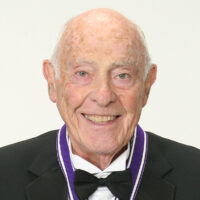
2011 Kyoto Prize Laureates
Materials Science and Engineering
/ Materials Scientist
1928 - 2016
Emeritus Senior NIST Fellow, National Institute of Standards and Technology/Affiliate Professor, University of Washington
Science during Paradigm Creation
2011
11 /11 Fri
Place:Kyoto International Conference Center
“Materials Science and Engineering of Multi-component Systems and the Future Prospects”
2011
11 /12 Sat
13:00 - 17:30
Place:Kyoto International Conference Center
Dr. John W. Cahn developed the theory of spinodal decomposition in alloy materials by incorporating the strain energy term into the free energy of the alloy system. It has made it possible to predict the optimal microstructures of alloy materials and to maximize their functions. The theory has led to the establishment of a design guideline for the development of alloy materials and contributed to the progress of both materials science and materials industry.
Among the structural and functional materials in common use today, only a few consist of a single component, while the large majority are alloy materials of two or more elements. To create alloy materials with ideal characteristics and functions, it is essential to control their composition and microstructure. Until the 1950s, researchers attempting to maximize the potential of alloy materials were forced to take a trial-and-error approach toward constituent selection and structural control, and design guides for optimizing the characteristics of alloy materials for specialized functions were eagerly sought.
The structure of an alloy material is determined by the requirement that its free energy of the alloy material must be a minimum. However, the techniques available to thermodynamics in the 1950s could deal mainly with homogeneous alloys. It was impossible to rigorously apply the free energy concept to controlling of the microstructure of heterogeneous alloys with microstructures formed by composition fluctuations.
Dr. John Werner Cahn established the theory of three-dimensional spinodal decomposition by extending the one-dimensional theory formulated by Dr. Mats Hillert and also by incorporating an elastic strain energy term into the free energy, leading to the intentional design of alloy materials with especially desirable characteristics. More specifically, Dr. Cahn became the first to demonstrate that the composition fluctuations needed to bring out the optimal properties of alloy materials may be determined by a materials structure formation theory based on the three dimensional spinodal decomposition, thereby proposing a technique to deal quantitatively with microstructures. This theory has since found application in the design and production of metals, glass, semiconductors, polymers, heat-resistant materials, and magnetic materials, which require a variety of properties and functions. Dr. Cahn’s research findings have also laid the foundations for the phase-field method, which is a structure formation simulation method, and also one of the hottest research topics of recent years.
As detailed above, Dr. Cahn made it possible to predict the optimal microstructures that would maximize the property and the functionality of alloy materials, by being the first to advocate that the formation and control of such materials’ microstructures resulting from spinodal decomposition may be determined by free energy in combination with elastic strain energy. Using this analysis and theory, materials scientists worldwide are now creating effective design guides for the development of new alloy materials. Consequently, Dr. Cahn’s work represents a significant contribution not only to the progress of materials science, but to the development of materials for modern society as a whole.
For these reasons, the Inamori Foundation is pleased to present the 2011 Kyoto Prize in Advanced Technology to Dr. John Werner Cahn.
Profile is at the time of the award.